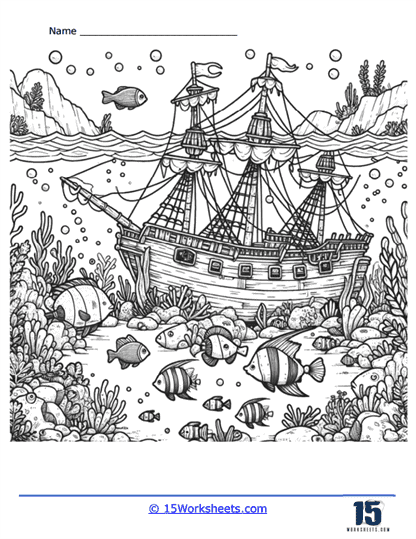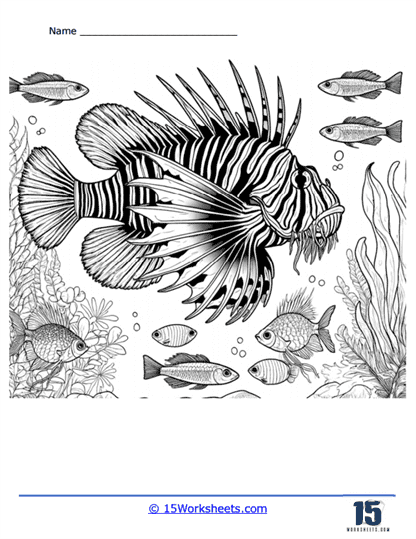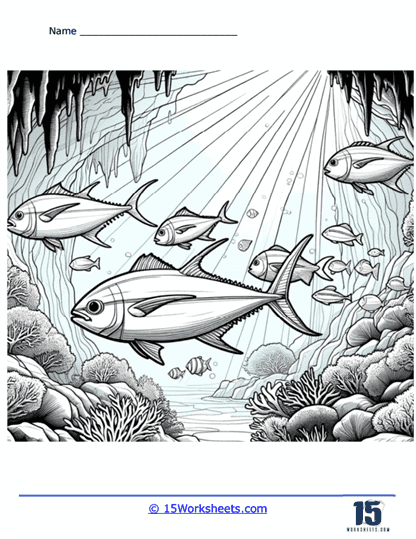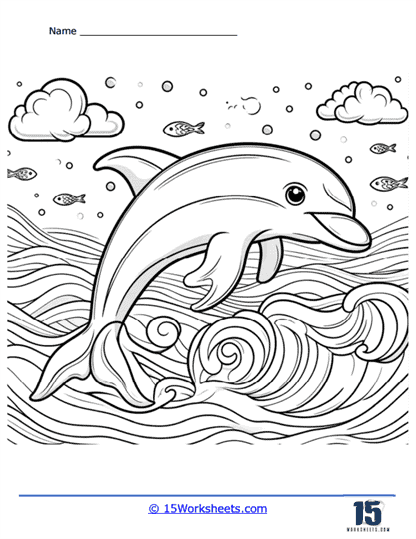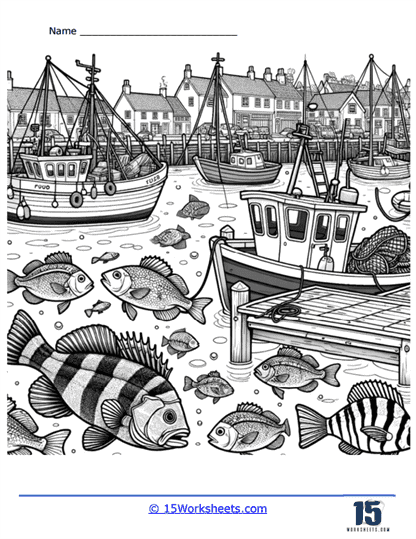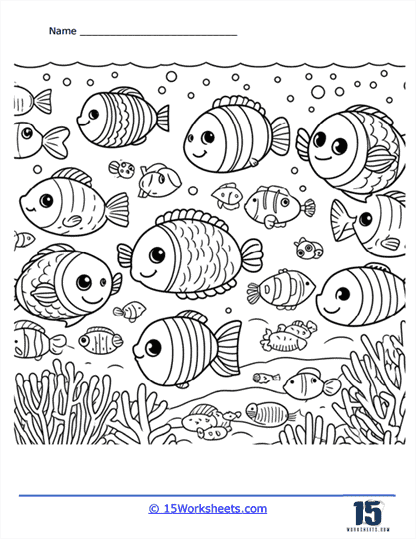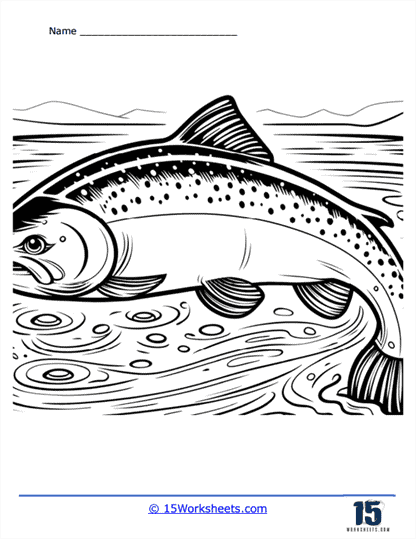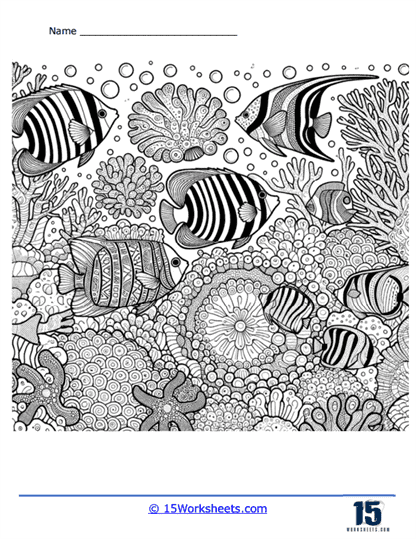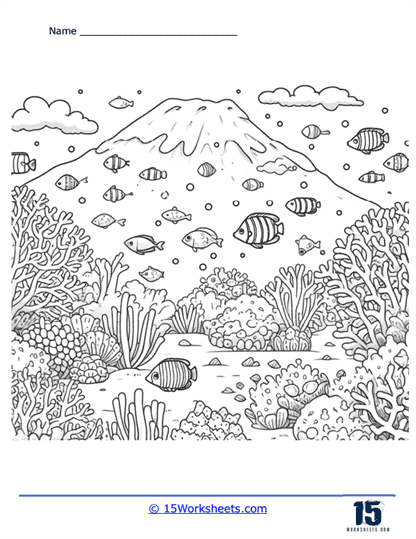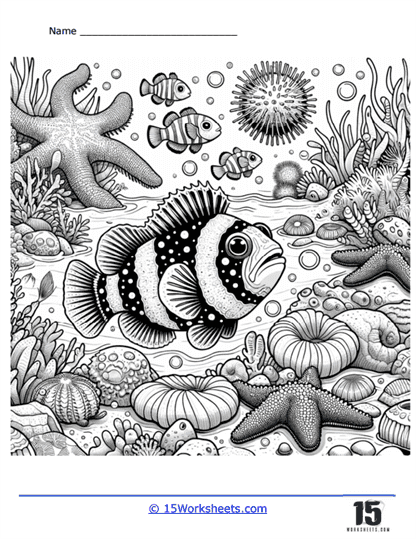Fish Worksheets
About These 15 Worksheets
This collection of coloring pages are a delightful and engaging resource for children and adults alike, providing an opportunity to explore the vibrant and diverse world of aquatic life. These pages typically feature a wide variety of fish species, each with unique shapes, patterns, and colors that captivate the imagination. They serve as both an educational tool and a relaxing creative activity, allowing individuals to learn about different fish while enjoying the therapeutic benefits of coloring.
These coloring pages are a versatile and engaging resource that offers a wide array of designs and themes. From simple outlines suitable for young children to intricate patterns for older kids and adults, these pages provide opportunities for artistic expression, education, and fun. Whether used to teach about different fish species and their habitats, raise awareness about environmental conservation, or simply as a relaxing activity, fish coloring pages hold a timeless appeal. They bridge the gap between learning and play, making them a valuable addition to any collection of coloring materials.
At the most basic level, fish coloring pages include simple outlines of various fish. These might be common species such as goldfish, clownfish, or bettas, which are easily recognizable and familiar to many. The simplicity of these images makes them suitable for young children who are just beginning to develop their fine motor skills and understanding of colors. Coloring these pages can help kids learn about the anatomy of fish, including their fins, tails, and scales.
Moving beyond basic representations, some fish coloring pages feature fish in their natural habitats. These pages might depict underwater scenes with fish swimming among coral reefs, seaweed, and other marine plants. Such pages can introduce children to the concept of ecosystems and the importance of different habitats for various species. They can also include other sea creatures such as starfish, sea turtles, and jellyfish, providing a broader view of marine biodiversity.
Another common type of fish coloring page showcases fish in various states of activity. These might include images of fish swimming in schools, jumping out of the water, or interacting with other marine life. These dynamic scenes add a sense of movement and excitement to the coloring activity, encouraging children to think about the behavior and lifestyles of different fish species. Additionally, these pages can be used to teach children about the social behavior of fish, such as how some species swim in groups for protection.
They include more detailed and scientifically accurate depictions of fish. These might feature specific species labeled with their names and distinctive features, making them a valuable resource for learning about marine biology. Some pages might include informational text about the fish, such as their habitat, diet, and unique adaptations. This combination of visual and textual information can enhance the educational value of the coloring activity, making it a fun way to learn about science.
Fish coloring pages can also be highly artistic, featuring intricate designs and patterns. These might include mandalas with fish motifs, detailed illustrations of koi fish with their beautiful scales, or abstract representations of underwater scenes. These designs cater to older children and adults who enjoy more complex coloring activities that require patience and attention to detail. They can also be used to explore different artistic styles and techniques, such as shading and blending.
Seasonal and holiday themes are also prevalent in fish coloring pages. For instance, summer-themed pages might showcase fish in tropical settings, with bright colors and fun elements like beach balls and sun hats. Halloween-themed pages might feature spooky underwater scenes with fish dressed in costumes or swimming among eerie seaweed. Similarly, Christmas-themed pages might depict fish with Santa hats or decorating an underwater Christmas tree. These themed pages add a festive twist to the coloring activity, making it even more enjoyable.
In addition to realistic and themed designs, fish coloring pages sometimes venture into the realm of fantasy. These pages might portray anthropomorphized fish, giving them human-like features such as faces, arms, and legs, and placing them in imaginative scenarios. For example, there might be pages featuring fish playing musical instruments, participating in sports, or having a tea party. These whimsical designs can be particularly engaging for young children, as they blend the familiar with the fantastical, sparking creativity and storytelling.
Fish coloring pages can also be used to teach about environmental conservation. Pages might include illustrations of fish swimming in clean, healthy waters, accompanied by text about the importance of protecting marine environments. Other pages might depict scenes of pollution and its impact on marine life, helping to raise awareness about environmental issues. These educational coloring pages can be a fun way to introduce children to the concept of environmental stewardship and the importance of protecting our oceans.
Some of the coloring pages are designed to be part of larger projects or activities. For instance, there might be pages that children can color, cut out, and assemble into 3D fish models or pages that are part of a larger storybook or activity book. These interactive elements add an extra layer of engagement and can be used in classroom settings or at home as part of arts and crafts activities. They also provide opportunities for children to practice skills such as cutting, gluing, and following instructions.
Cultural and historical contexts can also be explored through fish coloring pages. For example, pages might depict fish that are significant in different cultures, such as koi fish in Japanese culture or catfish in African folklore. These pages can provide a starting point for discussions about cultural traditions and the role of fish in different societies. They can also include illustrations of historical fishing methods and tools, giving children a glimpse into the past and the evolution of fishing practices.
Another interesting variation includes fish coloring pages that incorporate other aquatic life and environments, creating a broader scene of an underwater world. These pages might show a variety of fish swimming together with dolphins, whales, and other marine animals, promoting an understanding of biodiversity and the interconnectedness of marine ecosystems. They can also depict different types of water bodies, such as freshwater lakes, rivers, and oceans, helping children learn about the diversity of aquatic habitats.
In addition to the wide range of themes and designs, fish coloring pages can be found in various formats. Printable sheets are the most common, easily accessible online for parents and teachers to download and print at home or in the classroom. Some coloring books also focus on fish themes, providing a curated collection of pages bound together. Digital coloring pages are becoming increasingly popular, allowing users to color on tablets or computers using digital tools, which can be a mess-free and environmentally friendly option.
The popularity of these types of coloring pages can be attributed to several factors. Firstly, fish are a fascinating and diverse group of animals, making them an intriguing subject for coloring activities. Their varied shapes, patterns, and colors provide endless possibilities for creativity and artistic expression. Secondly, fish coloring pages offer educational value, helping children learn about marine biology, ecosystems, and environmental conservation. Finally, the act of coloring itself is relaxing and enjoyable, making it a popular pastime for people of all ages.





